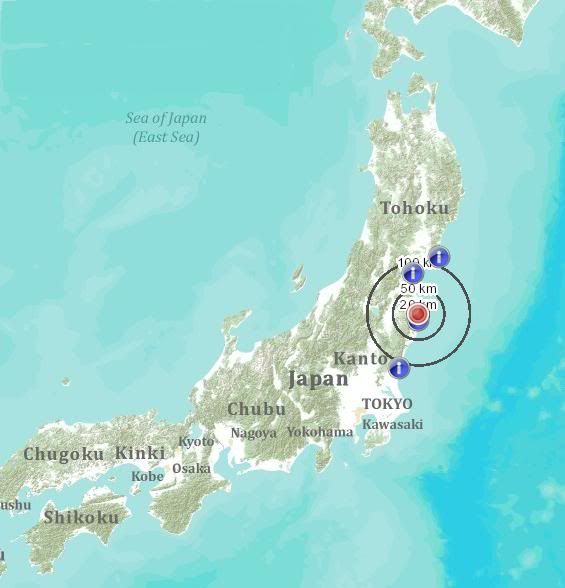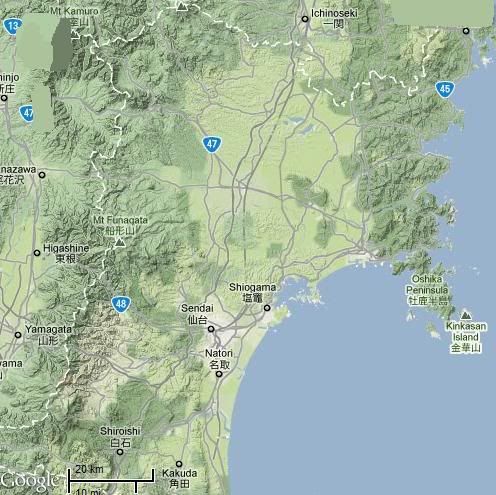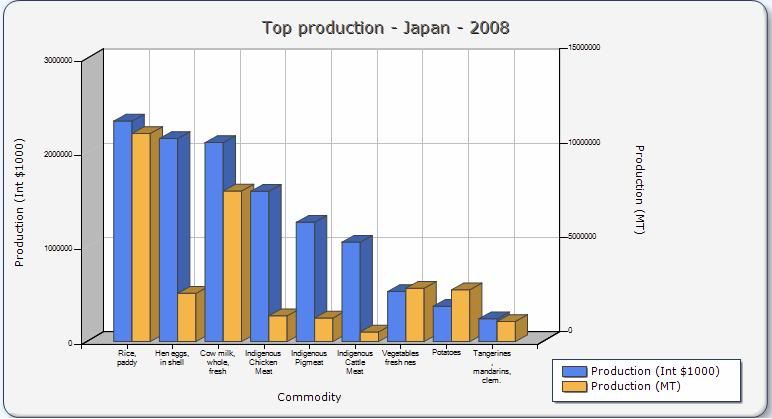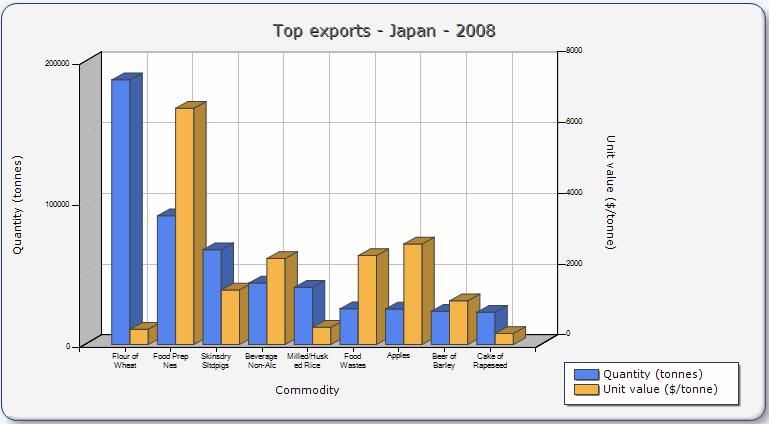
photo source: wikipedia
Because Japan is largely mountainous, only 12-13% of its land is farmed, or less than 19,000 square miles. The average farm size is less than five acres, and the average farmer is over 65 years of age. The nation imports 60% of its calories.
There may be Ag related infrastructure that needs to be replaced which might include energy, transport, rail, roads, storage facilities, feed mills, and possibly ports. What is the condition of Japan's grain storage facilities? The ports of Kobe, Tokyo, and Osaka should be largely undamaged by this event. The affected region represents 6-7% of Japan's total economy. Japan's sovereign debt burden is making some question the feasibility of rebuilding all that is necessary following this disaster.
Rice, in Japan, would normally be planted in April or May. It would seem doubtful that this event will be significant for their 2011 rice growing season assuming the farmers have no obstacles to working their small fields. Even if this results in Japan requiring more rice imports, the world currently has abundant stocks of rice at relatively low prices.
Japan's agricultural production in metric tons in 2004 included: rice 11 mmt, sugar beets 4.7 mmt; potatoes 2.9 mmt; cabbage 2.3 mmt; mandarin oranges 1.4 mmt; onions 1.1 mmt; sweet potatoes 1 mmt; apples .9 mmt; cucumbers .7 mmt, and other crops included melons, tomatoes, wheat, soybeans, tea, and tobacco.
Japan is the largest buyer of U.S. corn and the third largest buyer of U.S. soybeans. It buys 25% of the rice produced by California.

source: esri
Agricultural Production According to Region
The Tohoku area is primarily agricultural: 65% of cultivated land is rice paddy fields, which account for almost a quarter of all the paddy fields throughout the country.
Though agricultural activity has decreased in general, it is still thriving in the areas to the east and north (of Tokyo), and contributes to the region’s economy.
The Chubu region has some of Japan’s longest rivers and one of the largest rice producing areas, located along the Sea of Japan. In addition to rice, agricultural products include tea, mandarin oranges, strawberries, grapes, peaches, and apples.
In the Kinki region (which includes Kyoto): Kobe is one of Japan’s most important ports, which form the center of commerce for western Japan. Rice and citrus fruit production, lumbering, and fishing are all important to the region’s economy.
Chugoku region: Large rice producing areas are concentrated along the plains of the Sea of Japan and the Okayama Plain. The warm, dry climate of the Inland Sea coast is ideal for growing oranges.
Kyushu, the southernmost of the four major islands, and more than 1,400 surrounding islands make up the Kyushu region. Kyushu Island has a mountainous interior, with plains along the coast, volcanoes, and hot springs. The climate is subtropical. Agriculture, stock farming, hog raising, and fishery all flourish.
Osaka is the financial center of western Japan. It is an industrial center as well, especially for chemicals, machinery, steel, and metal. Both the Tokaido Shinkansen and the Sanyo Shinkansen depart from and arrive at Shin-Osaka station (with the exception of some trains going from Tokyo through to Hakata, Kyushu, or Hiroshima).

The above region was nearer the epicenter and is a rice-producing area of Japan. The farming region shown in the map might be about 700 square miles, or less than 4% of Japan's farmland, and it is hard to say how much of it was impacted. Much of the northeastern coast is very mountainous, so that region hit by the tsunami should not have destroyed much farmland.
Ben Savage, the managing director for rice at Jackson Son & Company in London, one of the world’s oldest rice brokerage houses, told the NYT's that the tsunami was unlikely to have much of an effect on global rice prices because rice tends to be fairly tolerant of the temporary ingress of salt water into paddies but a separate concern is that many areas immediately adjacent to the ocean are now used for aquaculture of shrimp and fish and may be damaged.
According to Agrimoney, Japan's farm ministry reported that 4.8m tonnes of the 24m tonnes of feed that Japan produces each year come from the northern areas near the center of the disaster. Feed mills store grain and process corn and soybeans into feed.
On March 11th Japan's ministry reported:
“Some ports in northern Japan, Kushiro, Hachinohe, Ishinomaki and Kashima, were hit by the tsunami. We’ve heard some feed mills and livestock operations have also been damaged by the tsunami. Those facilities were not severely damaged by the earthquake itself but were affected by the tsunami,” said Tommy Hamamoto, USGC director in Japan. “It is too early to tell what effect this will have on Japan’s agricultural sector, but it could be of significance.”

In 2008, Japan ranked tenth in world rice production, according to the FAO.


Wikipedia Facts about Japanese Agriculture
- The share of net agricultural production in GNP was 3% in 1989.
- In the late 1980s, 85.5 % of Japan's farmers were also engaged in occupations outside of farming, and most of these part-time farmers earned most of their income from nonfarming activities.
- Rice output swelled to over 14 million metric tons in the late 1960s, a direct result of greater cultivated area and increased yield per unit area, owing to improved cultivation techniques. Now rice production is near 8 MMT making it nearly self-sufficient in rice.
- Rice paddies occupy most of the countryside, whether on the alluvial plains, the terraced slopes, or wetlands and coastal bays.
- Non-paddy farmland share the terraces and lower slopes and are planted with wheat and barley in the autumn and with sweet potatoes, vegetables, and dry rice in the summer.
- Intercropping is common: such crops are alternated with beans and peas.
- In 1990, Japan was 67% self-sufficient in agricultural products and provided for around 30% of its cereal and fodder needs.
- Beef cattle are mostly concentrated in western Honshū, and on Kyūshū.
- Hogs, the oldest domesticated animals raised for food, are found everywhere. Pork is the most popular meat.
- The rice seasons in Northern Japan last from May–June to September–October. In central Japan, it is from April–May to August–October. In southern Japan the rice season is form April -May to August–September.
- About 85% of the 2.3 million farms in Japan plant rice yearly.
- The average Japanese rice farmer works only 1.65 acres.
- Japan subsidizes rice production heavily because it feels that self-sufficiency in rice is important for food security purposes.
All in all, it is not my impression that there will be significant repercussions in the global agricultural situation which will result from this disaster. Even Japan's rice production may not be affected by a significant amount. It would seem logical that they may need to increase Ag imports if they need to replace any grain damaged in storage. I am curious about the condition of their aquaculture, since that has become quite significant to them. The rubber commodity has taken an early hit based upon Japan's automobile manufacturing. If the new energy issues facing Japan lead to a higher global demand for oil, that could also have a slight impact on global agricultural production. My main concern would be this event's effects upon global macro economic conditions, which, in turn, have significant effects upon the Ag sector.
K. McDonald
ALSO SEE UPDATE April 7, 2011: Update on Japan's Agriculture Following the Recent Tsunami
sources:
Regions of Japan [pdf]
esri map of tsunami
Also see: earthtrends
ALSO SEE POST: Maps of the Japan Nuclear Reactors, Tsunami, and Farmland Areas